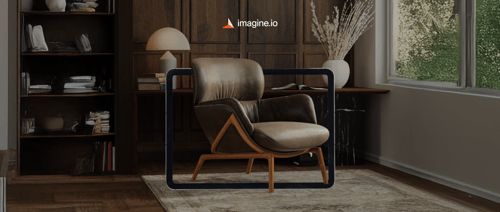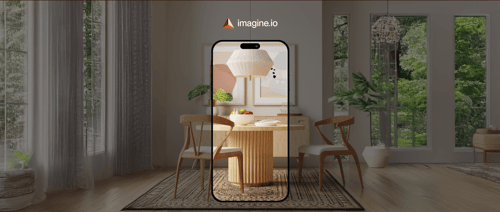AI product image generation revolutionizes how furniture retailers create and display inventory. This technology enables automated, high-quality visuals that enhance customer experience.
Quick Listen:
Imagine scrolling through an online furniture catalog where every piece seems tailor-made for your living room colors matching your walls, styles blending seamlessly with your decor. This isn't a distant dream; it's the reality AI is crafting for furniture retailers today. As eCommerce booms, high-quality visuals have become the linchpin of sales, and artificial intelligence is stepping in to revolutionize how these images come to life. With the global market for AI-powered image generators valued at $257.175 million in 2022 and set to surge to $917.448 million by 2030, growing at a compound annual rate of 17.4%, furniture sellers can't afford to ignore this shift. In this deep dive into AI in Product Image Generation: What Furniture Retailers Should Know, we'll uncover how this technology is not just enhancing visuals but transforming the entire retail landscape.
The Power of AI in Furniture Retail
Furniture retail has always hinged on visuals. Customers don't just buy a couch; they envision it in their space. Traditional photography, however, comes with hurdles expensive shoots, logistical nightmares for bulky items, and limited flexibility for custom options. AI changes that equation dramatically. By harnessing machine learning algorithms rooted in deep neural networks, AI image generators craft stunning visuals from mere descriptions or data inputs. These systems, trained on enormous collections of images, produce artwork and content autonomously, bypassing the need for human-led sessions.
North America has led this charge, commanding a 39.99% share of the global AI image generator market in 2022. Retailers here recognize that superior images drive engagement and conversions. As deep learning evolves, particularly through techniques like generative adversarial networks or GANs these tools create hyper-realistic outputs by having neural networks compete to refine results. The outcome? Images so vivid they rival professional photography, all generated in moments. This isn't hype; it's backed by rapid advancements in AI, fueling a market projected to hit $1.08 billion by 2030 with a 17.7% CAGR from 2024 onward, according to industry analyses.
The software side dominates, holding 79% of the market in 2023, while sectors like media and entertainment lead in adoption. For furniture, this means AI isn't just a tool it's a strategic asset, enabling retailers to populate catalogs with diverse, high-quality visuals that captivate shoppers and streamline operations.
Emerging Trends in Product Visualization
The furniture industry is witnessing a surge in AI-driven innovations that go beyond static images. One standout trend is the fusion of AI with augmented reality, or AR, creating interactive experiences where customers can virtually place furniture in their homes. Progressive GANs and style-based variants are pushing boundaries, yielding sharper, more lifelike visuals that integrate seamlessly with AR and VR setups. This integration meets the rising demand for immersive content, expanding applications across eCommerce.
Personalization takes center stage too. AI tailors images to individual tastes swapping fabrics, adjusting lighting, or even altering room settings on the fly. In Asia Pacific, poised for the fastest growth in the AI image generator market through 2030, retailers are leveraging these capabilities to cater to diverse consumer preferences. North America, with its 37.5% revenue share in 2023, continues to innovate, driven by ongoing R&D that enhances image quality and realism.
These trends stem from breakthroughs in deep learning, where GANs revolutionize generation by pitting networks against each other, resulting in outputs that evolve with each iteration. As visual content demands soar, AI positions itself as indispensable, promising growth fueled by technological leaps and broader use cases.
Real-World Applications and Case Studies
Real retailers are already reaping rewards. Take IKEA, a pioneer in blending AI with AR for home visualization. Their tools let shoppers see furniture in personalized settings, generating dynamic visuals that adapt to user inputs. This approach not only boosts engagement but slashes return rates by ensuring fit and style match expectations. Wayfair follows suit with its "View in Room" feature, using AI to create 3D renders and photorealistic images, allowing customers to visualize products in their spaces without physical prototypes.
Furniture.com employs generative AI in its Find It AI search tool, generating images based on shopper queries to match intent with catalog items. This streamlines discovery, turning vague searches into precise visual matches. CITY Furniture, partnering with visual AI specialists, implemented camera search and similar-item recommendations, enabling uploads for instant matches. The result? A 26.3% uplift in average order value and a 5.27 times higher conversion rate, proving AI's prowess in enhancing product discovery through visualization.
These applications scale effortlessly. AI generates thousands of images or videos, reducing manual labor. For instance, retailers create lifestyle scenes from CAD files, prototyping designs pre-manufacture. Benefits echo across the board: faster launches, cost cuts up to 70% by ditching studios, and heightened customer trust through accurate depictions.
Key Challenges and Limitations
Despite the promise, hurdles remain. Quality control demands vigilance; inconsistent algorithms might yield off-brand or flawed images, like mismatched textures on a table. Retailers must enforce strict guidelines to maintain uniformity. Technical integration poses another barrier meshing AI with legacy systems requires expertise, and the software-heavy market (79% share) underscores the need for user-friendly platforms.
Data dependency is critical. AI thrives on vast, pristine datasets; subpar inputs lead to subpar outputs. Creative direction and usage rights add layers ensuring generated content aligns with brand ethics and legal standards. As noted in industry insights, selecting tools with seamless workflows is key to overcoming these, turning potential pitfalls into managed processes.
Yet, these challenges foster innovation. Retailers investing in accurate data and training navigate them successfully, emerging with efficient, reliable AI pipelines that elevate their visuals.
Opportunities and Business Impacts
AI unlocks profound opportunities. Time to market shrinks dramatically generate visuals pre-production, accelerating from concept to online listing. Cost efficiencies shine: bypass expensive shoots, saving up to 70% while scaling output. Customization flourishes, offering buyers endless variants, boosting satisfaction and loyalty.
Customer experiences transform. Interactive visuals build immersion, driving conversions in a market where media and entertainment lead adoption. For furniture, this means lower returns, higher engagement, and competitive edges. Broader impacts include SEO gains from optimized images and metadata, plus operational streamlining for marketing teams.
As the AI image generator market eyes $1.08 billion by 2030, furniture retailers stand to gain immensely, leveraging trends like AR integration for sustained growth.
A Future Shaped by AI
The trajectory is clear: AI will redefine furniture retail, making it more agile and customer-centric. With a 17.7% CAGR ahead, adoption isn't optional it's essential. Retailers should start small: evaluate tools for fit, prioritize data quality, and pilot with key lines. Partnerships with AI providers can ease integration, ensuring long-term success.
In this evolving landscape, those embracing AI-driven image generation won't just survive; they'll thrive, setting new standards in visual excellence and business efficiency.
Frequently Asked Questions
How much can furniture retailers save by using AI image generation instead of traditional photography?
Furniture retailers can save up to 70% on photography costs by using AI image generation instead of traditional studio shoots. AI eliminates the need for expensive photography sessions, logistics for bulky furniture items, and physical prototypes. This technology allows retailers to generate thousands of high-quality product images quickly and cost-effectively, while also accelerating time-to-market for new products.
What are the main benefits of AI-powered product visualization for furniture eCommerce?
AI-powered product visualization offers furniture retailers several key advantages: dramatically reduced return rates through accurate product representation, enhanced customer engagement with personalized and interactive visuals, and the ability to create endless product variants without additional photography. Real-world examples show significant results, with some retailers experiencing a 26.3% increase in average order value and 5.27 times higher conversion rates after implementing AI visualization tools.
How is AI image generation technology expected to grow in the furniture retail market?
The AI image generator market is experiencing explosive growth, valued at $257.175 million in 2022 and projected to reach $917.448 million by 2030, with a compound annual growth rate of 17.4%. For furniture retailers specifically, this growth is driven by advances in deep learning technologies like Generative Adversarial Networks (GANs) and increasing integration with augmented reality (AR) for immersive shopping experiences. North America currently leads the market with a 39.99% share, while Asia Pacific is poised for the fastest growth through 2030.
Disclaimer: The above helpful resources content contains personal opinions and experiences. The information provided is for general knowledge and does not constitute professional advice.
You may also be interested in: How 3D Rendering Can Make or Break Your Industrial Design Pitch
Struggling with expensive, outdated product visuals that slow down your creative process and stunt eCommerce growth? imagine.io's AI-powered platform empowers furniture, home décor, and textile brands to effortlessly produce striking 3D images, immersive videos, AR experiences, and interactive configurators. Cut production costs up to 70%, boost conversions 5X, speed up prototyping, and supercharge your online sales. Ready to elevate your product visuals and captivate customers? Book a demo with imagine.io today!
Powered by flareAI.co




.png?width=500&name=How%20to%20Add%20a%203D%20Product%20Configurator%20to%20Your%20WordPress%20Website%20(Complete%20B2B%20Guide).png)
















%20(1).png?width=500&name=Why%20Exploded%20Mattress%20Views%20Matter%20(And%20How%20to%20Generate%20Them)%20(1).png)
.png?width=500&name=Best%20Shopify%20Product%20Configurator_%20How%20to%20Choose%20the%20Right%20One%20(2).png)
.png?width=500&name=Why%20Exploded%20Mattress%20Views%20Matter%20(And%20How%20to%20Generate%20Them).png)



.png?width=500&name=Best%20Shopify%20Product%20Configurator_%20How%20to%20Choose%20the%20Right%20One%20(1).png)







.png?width=500&name=How%203D%20Rendering%20Can%20Make%20or%20Break%20Your%20Industrial%20Design%20Pitch%20(1).png)








%20with%20Digital%20Twins%20and%203D%20Visualization.png?width=500&name=Optimizing%20Your%20Digital%20Asset%20Management%20(DAM)%20with%20Digital%20Twins%20and%203D%20Visualization.png)




.png?width=500&name=Styling%20Home%20Decor%20for%202025_%20From%20Global%20Influences%20to%20Playful%20Personalization%20(1).png)
